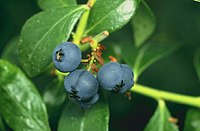
Photo from wikipedia
Leaf tissue testing is a useful tool for monitoring nutrient requirements in northern highbush blueberry (Vaccinium corymbosum L.; abbreviated as “blueberry”) but may require adaptation to specific growing environments. The… Click to show full abstract
Leaf tissue testing is a useful tool for monitoring nutrient requirements in northern highbush blueberry (Vaccinium corymbosum L.; abbreviated as “blueberry”) but may require adaptation to specific growing environments. The objective of this study was to evaluate macronutrient concentrations in early-, mid-, and late-season blueberry cultivars grown in two contrasting environments, specifically eastern and western Washington. Climate and soil conditions between these two regions differ tremendously with eastern Washington being more arid with naturally calcareous soils lower in soil organic matter. Sampling was conducted over a 3-year period in commercial fields. Leaf tissue nitrogen (N), phosphorus (P), potassium (K), calcium (Ca), magnesium (Mg) and sulfur (S) concentrations were affected by year (Y), growing region (R), cultivar (C), and Day of Year (DOY) that the samples were collected with many interactions. Leaf nutrient concentrations were higher, on average, in western than eastern Washington except for Ca and Mg, indicating sufficiency levels should differ between these regions. Leaf macronutrients generally stabilized between DOY 212–243 (1–31 August), suggesting this period is optimal for tissue sampling. Findings from this study demonstrate the importance of considering regional effects and may be applicable for blueberry cultivated in similar pedo-climactic conditions around the world.
Journal Title: Plants
Year Published: 2022
Link to full text (if available)
Share on Social Media: Sign Up to like & get
recommendations!